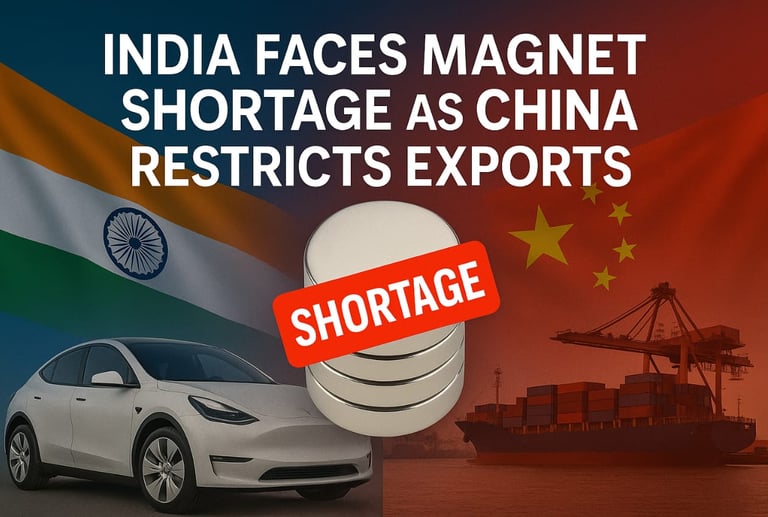India Faces Magnet Crisis as China Curbs Rare Earth Exports – EV Industry in Trouble
India’s EV sector hit by rare earth magnet shortage after China’s export curbs. Bajaj, Enfield warn of zero production. Govt plans urgent supply chain reforms.
Raja Awais Ali
8/1/20252 min read


India Faces Critical Magnet Shortage as China Tightens Export Controls, EV Industry at Risk
India’s electric vehicle (EV) sector has hit a major roadblock as China imposed stricter export controls on rare earth magnets — a key component in EV motors, wind turbines, drones, and defense systems. These magnets, especially neodymium and dysprosium-based variants, are critical for the smooth functioning of next-generation green technologies. The move, announced in late July, began impacting Indian companies from 1 August 2025.
Leading Indian auto manufacturers like Bajaj Auto and Royal Enfield are now warning of production halts in August due to the non-arrival of critical shipments since April. Bajaj officials revealed that their electric scooter “Chetak” and three-wheeler “Gogo” may face zero production for the entire month, as magnet inventories are depleted.
China’s Ministry of Commerce revised its export policy earlier this year, making it mandatory for foreign buyers to obtain end-user certificates, strategic approvals, and export licenses for all rare earth magnet-related exports. India, which depends on China for more than 85% of its rare earth magnet supply, is now facing the consequences of this supply chain disruption.
In response, India’s Ministry of Commerce and Industry held an emergency meeting on 1 August and announced a three-step strategy to mitigate the crisis:
1. Boost local manufacturing of rare earth magnets through incentives and government support.
2. Engage diplomatically with China to negotiate flexible trade terms.
3. Diversify import sources, looking toward countries like Japan, Vietnam, and Australia.
Officials from Indian Rare Earths Limited (IREL), a government-owned mining and processing entity, stated that the country aims to become self-sufficient in magnet production by 2026, but until then, the industry will need short-term solutions.
Analysts warn that without quick action, the EV sector — a cornerstone of India’s green mobility push — could face losses in production, exports, and even job cuts. Already, share prices of magnet-reliant companies have begun to dip on the Bombay Stock Exchange (BSE), raising concerns among investors.
Interestingly, companies like Hyundai Motor India had anticipated potential disruptions and secured extra inventory earlier this year. Their production is likely to continue in the short term. However, smaller and mid-sized players may not survive prolonged shortages.
This situation highlights India’s vulnerability in critical supply chains, especially those tied to green technology and national security. With growing geopolitical tensions and protectionist policies, experts emphasize that India must prioritize domestic capacity and reduce dependency on strategic imports from any single country.
As the government explores long-term strategies, the next few weeks will be crucial for the EV industry. Whether India can respond effectively and keep its ambitious green goals on track remains to be seen.